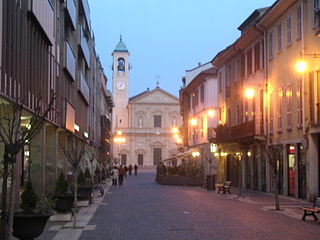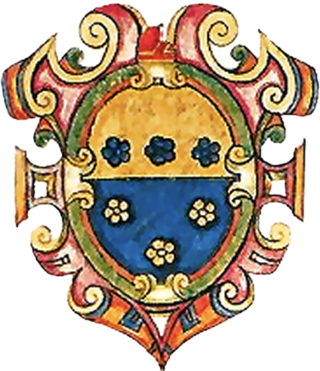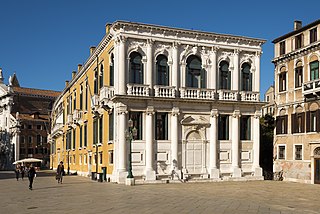
Lodi is a city and comune in Lombardy, northern Italy, primarily on the western bank of the River Adda. It is the capital of the province of Lodi.
Santo Stefano is the Italian name of Saint Stephen.

Pesaro is a comune (municipality) in the Italian region of Marche, capital of the province of Pesaro and Urbino, on the Adriatic Sea. According to the 2011 census, its population was 95,011, making it the second most populous city in the Marche, after Ancona. Pesaro was dubbed the "Cycling City" by the Italian environmentalist association Legambiente in recognition of its extensive network of bicycle paths and promotion of cycling. It is also known as "City of Music", for it is the birthplace of the composer Gioachino Rossini. In 2015 the Italian Government applied for Pesaro to be declared a "Creative City" in UNESCO's World Heritage Sites. In 2017 Pesaro received the European City of Sport award together with Aosta, Cagliari and Vicenza.

Caltagirone is an inland city and comune in the Metropolitan City of Catania, on the island of Sicily, Southern Italy, about 70 kilometres (43 mi) southwest of Catania.

Giuseppe Lanza, Duke of Camastra, was a 17th-century Sicilian nobleman who oversaw the reconstruction of many Sicilian towns and cities following the earthquake of 1693.

Grottaglie is a town and comune in the province of Taranto, Apulia, in southern Italy.

Saronno is a comune of Lombardy, Italy, in the province of Varese. It received the honorary title of city with a presidential decree in 1960. With an estimated population of 39351 inhabitants, it is the most densely populated among the big municipalities in its province.

The Palazzo Poli is a palace in Rome, Italy, that was altered in the 18th century to form the backdrop to the Trevi Fountain.

Santo Stefano di Sessanio is a comune and hill town in the province of L'Aquila in the Abruzzo region of southern Italy. Located in the Gran Sasso e Monti della Laga National Park, in the highest region of the Apennines, this medieval hill town sits adjacent to the high plain of Campo Imperatore. It is one of I Borghi più belli d'Italia.

Palazzo Mozzi or Palazzo de' Mozzi is an early Renaissance palace, located at the end of the Piazza de' Mozzi that emerges from Ponte alle Grazie and leads straight to the palace where via San Niccolò becomes via de' Bardi in the Quartiere of Santo Spirito in the Oltrarno section of Florence, region of Tuscany, Italy. The 13th-century palace housed the gallery of the highly successful antiquarian Stefano Bardini, of which the remnants were left to the commune, where they assembled the Museo Bardini or Mozzi Bardini, displaying Florentine art and artifacts up to the early Renaissance. The gardens elaborated against the hillside behind the palace were added mainly by Bardini.
Putignano is an Italian town of 26,644 inhabitants located in the Murgia of the Metropolitan City of Bari, in Apulia, southern Italy. It is known for its ancient Carnival, for textile manufacturing companies and for karst caves.

Mistretta is a comune (municipality) in the Metropolitan City of Messina in the Italian region Sicily, located about 90 kilometres (56 mi) east of Palermo and about 110 kilometres (68 mi) west of Messina.
Reitano is a comune (municipality) in the Metropolitan City of Messina in the Italian region of Sicily, about 90 kilometres (56 mi) east of Palermo and about 110 kilometres (68 mi) west of Messina.

Santo Stefano di Camastra is a comune (municipality) in the Metropolitan City of Messina in the Italian region Sicily, located about 100 km east of Palermo and about 135 km west of Messina.
Canneto is a village and civil parish (frazione) of the Italian municipality of Caronia, in the Province of Messina, Sicily. In Italian language its name means reed bed.

The Palazzo Bolognini Amorini Salina is a Renaissance architecture palace located on Piazza Santo Stefano in the center of Bologna, region of Emilia-Romagna, Italy. The Palace is notable by its circular niches with busts on the facade. The palace is still owned by descendant of the 16th-century Senatorial family.

Lanza are an Italian noble family that originated in Sicily in the 15th century. Derived from a cadet branch of the Lancia family, barons of Longi, it represents one of the major dynasties of the Sicilian aristocracy.

The Chiesa del Calvario is a church located in Santo Stefano di Camastra in Sicily.

The House of Loredan-Santo Stefano was a cadet branch of the House of Loredan that existed from the 14th century until 1767. The branch was mainly settled in the Palazzo Loredan in Campo Santo Stefano, which they acquired in 1536 from the Mocenigo family. The progenitor of the branch is considered to be Gerolamo Loredan "dal Barbaro" di S. Vitale (d.~1474), father of Doge Leonardo Loredan and Dogaressa Caterina Loredan. Besides Leonardo, the branch also gave Doge Francesco Loredan.

The Palazzo Loredan at Campo Santo Stefano is a palace in the San Marco district of Venice, overlooking Campo Santo Stefano. Before the acquisition by the Loredan family in 1536 and the restoration by the architect Antonio Abbondi, it was a group of adjacent buildings, in the Gothic style, belonging to the Mocenigo family. The purchased buildings were substantially restored and made into a single building for the residence of the wealthy noble family of Loredan. The palace has throughout history been home to at least seven Doges of Venice.
















